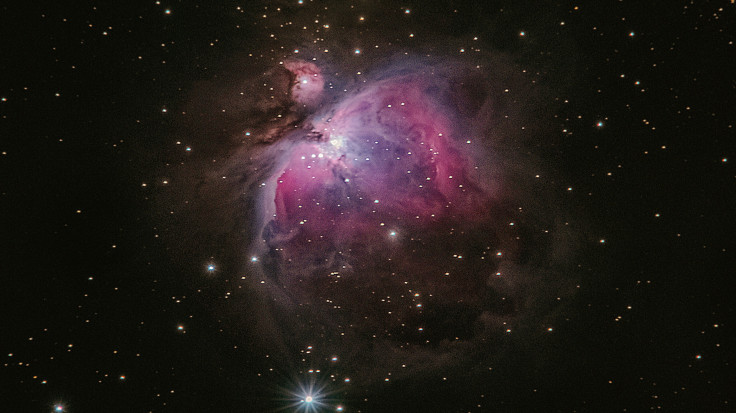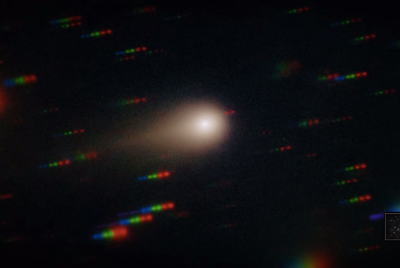Sun Blasts 3I/ATLAS: 'Alien Craft' Theory Faces Ultimate Test
Interstellar object 3I/ATLAS was just hit by a solar blast, putting the "alien craft" theory to the test.

In the vast, silent theatre of space, a rare drama is unfolding. On one side, a mysterious visitor from beyond our solar system, an object named 3I/ATLAS. On the other, a violent, billion-tonne explosion from our own Sun, a coronal mass ejection. Astronomers realised with palpable excitement that these two celestial phenomena were on a direct collision course.
Interstellar objects straying into our neighbourhood are incredibly rare; in fact, 3I/ATLAS—first discovered on 1 July 2025, by the ATLAS survey in Chile—is just the third ever observed. While coronal mass ejections are more common, they certainly do not happen every day.
The chance of one hitting a known interstellar target is astronomically small. That collision should have just happened, following the object's closest approach to the Sun (perihelion) on 29 October 2025, and the scientific community is now holding its collective breath, anxiously waiting for the data to pour in for analysis.
This event is more than just a cosmic light show. It represents an unprecedented scientific opportunity. When the Sun's plasma cloud—a torrent of magnetised particles—slams into the object, its reaction will tell us volumes. We might see a tail of gas and dust, known as a coma, dramatically change shape or even be stripped away entirely.
How 3I/ATLAS behaves under this solar assault will provide crucial clues about its composition, its density, and its origins from a distant, unknown star system.

Echoes from 2007: A Precedent for 3I/ATLAS?
We have seen something similar to this before, but with a critical difference. The last time a solar blast and a small body were seen interacting so clearly was in April of 2007. Back then, an asteroid from within our own solar system had an encounter with the Sun's plasma.
NASA's STEREO A spacecraft was perfectly positioned to watch the event unfold. When the collision occurred, the asteroid, which was venting material, briefly lost its tail. The intense solar material effectively 'blew it away'. In a 2015 blog post, NASA wrote:
'The effect, however, was only temporary — within minutes a new tail formed'.

Why 3I/ATLAS Is a Different Kind of Target
But 3I/ATLAS is not a familiar, local asteroid. It is an alien, in the truest sense of the word, and researchers do not have a complete picture of its makeup. Recent observations from the James Webb Space Telescope and Hubble have confirmed it is an active comet, but one with a strange composition that is rich in nickel. This interaction may be profoundly different. For one, this object is a true heavyweight.
While the 2007 asteroid was small, 3I/ATLAS is a behemoth, weighing as much as 33 billion tons with an estimated nucleus between 440 metres and 5.6 kilometres wide. Its sheer size and bizarre chemical composition—is it rock, ice, or something else entirely?—mean its reaction to the coronal mass ejection is anyone's guess. Will it shrug off the blast, or will it shed its outer layers in a spectacular display?
The Watchful Wait: Is 3I/ATLAS Friend, Foe, or Rock?
The timing could not be better. The object is expected to be passing by Mars 'anytime now'. As it gets closer, it will swing into the view of many more powerful telescopes and instruments, allowing for much more detailed analysis.
In fact, the Virtual Telescope Project is livestreaming new views of the object on 16 November. Beyond recording the aftermath of the solar blast, these new observations will help astronomers confirm its identity.
This is a critical test, as some have suggested it is something more exotic. Harvard astronomer Avi Loeb has been the most prominent voice of this theory, pointing to genuine scientific anomalies. The object is travelling at an astonishing 137,000 MPH.
This incredible velocity, combined with what has been described as an 'unusual shape' and strange "anti-tail" jets pointing towards the Sun, has led Loeb to suggest the possibility that it is an alien craft. Perhaps it is an asteroid that was intentionally modified by intelligent life and sent in our direction.

NASA, for its part, downplays that tantalising possibility. That natural explanation has been strongly bolstered by a new, major discovery: astronomers using the MeerKAT radio telescope in South Africa recently detected a faint radio signal from 3I/ATLAS. This signal was not a message, but the chemical signature of hydroxyl radicals (OH), a key component of water vapour.
This is a classic sign of a comet's ice turning to gas, or 'outgassing', as it is warmed by the Sun. The agency remains confident that the upcoming, clearer views will provide a definitive explanation, ruling out the 'alien' hypothesis entirely. For now, the world's astronomical centres can only wait, watch, and analyse.
The Sun's blast has passed, and the scientific world is now on the edge of its seat. Will the data pouring in from this unprecedented event confirm 3I/ATLAS as a bizarre-but-natural comet, just as the MeerKAT telescope's water vapour detection suggests? Or will its reaction to the solar plasma reveal new anomalies, keeping the "alien craft" debate alive? The verdict is about to come in.
© Copyright IBTimes 2025. All rights reserved.




















